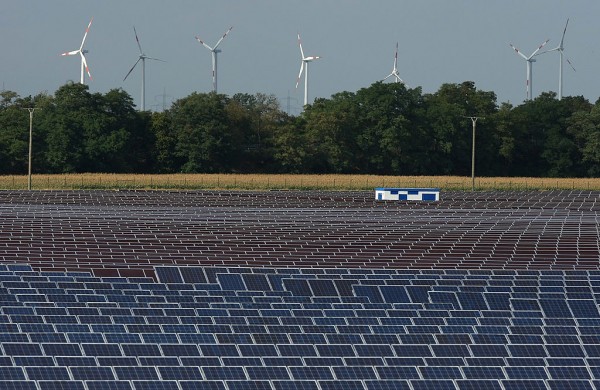Solar, Wind Energy Could Pump $2T to China's GDP by 2030
| Prei Dy | | Apr 13, 2017 01:45 PM EDT |
(Photo : Getty Images) A massive investment program in clean energy is slated to attract 5.4 trillion yuan ($780 billion) of new investments into the Chinese energy system over the next 15 years.
China's wind and solar industry is anticipated to increase fivefold by 2030, significantly boosting the country's GDP, according to Greenpeace.
A massive investment program in clean energy is slated to attract 5.4 trillion yuan ($780 billion) of new investments into the Chinese energy system over the next 15 years. And the wind and solar sectors could pump a whopping 14.3 trillion ($2 trillion) into the country's GDP. By 2030, China's wind and solar industries would be worth 1.57 trillion ($230 billion) and contribute 1.1 percent of China's annual GDP, Business Green reported.
Like Us on Facebook
"The potential benefits of wind and solar energy in China are staggering," Yuan Ying, climate and energy campaigner of Greenpeace East Asia, said. "Not only could China rid itself of fossil energy sources to the tune of 300 million tonnes of standard coal, it could also save enough water to meet the annual basic needs of 200 million people and add billions of dollars to the national economy."
Demand for direct job opportunities is also expected to leap fourfold to 2.4 million. And indirect jobs like transportation and raw material production is forecasted to increase to 5.3 million in 2030 from 1 million in 2015. Overall, China's wind and solar industries will employ 7.7 million people by 2030.
Ditching coal for emissions-free renewable energy could also bring financial gains. The external environmental benefits are slated to reach 0.3 RMB/kWh, amounting to 456 billion yuan ($66 billion) as a result of replacing fossil energy sources. In 2015, the two industries added about 0.16 RMB/kWh.
Coal-powered plants could also bring water crisis to the country since they consume massive amounts of water. In 2015, the development of solar and wind energies reduced water consumption by 0.57 billion cubic meter. The figure is forecasted to increase to as high as 3.6 billion cubic meter per year in 2030, which is equivalent to the yearly basic needs of 200 million citizens.
Tagsrenewable energy, solar power, Wind energy, china, China GDP, Greenpeace
©2015 Chinatopix All rights reserved. Do not reproduce without permission
EDITOR'S PICKS
-

Did the Trump administration just announce plans for a trade war with ‘hostile’ China and Russia?
-

US Senate passes Taiwan travel bill slammed by China
-

As Yan Sihong’s family grieves, here are other Chinese students who went missing abroad. Some have never been found
-

Beijing blasts Western critics who ‘smear China’ with the term sharp power
-

China Envoy Seeks to Defuse Tensions With U.S. as a Trade War Brews
-

Singapore's Deputy PM Provides Bitcoin Vote of Confidence Amid China's Blanket Bans
-

China warns investors over risks in overseas virtual currency trading
-

Chinese government most trustworthy: survey
-

Kashima Antlers On Course For Back-To-Back Titles
MOST POPULAR
LATEST NEWS
Zhou Yongkang: China's Former Security Chief Sentenced to Life in Prison

China's former Chief of the Ministry of Public Security, Zhou Yongkang, has been given a life sentence after he was found guilty of abusing his office, bribery and deliberately ... Full Article
TRENDING STORY

China Pork Prices Expected to Stabilize As The Supplies Recover

Elephone P9000 Smartphone is now on Sale on Amazon India

There's a Big Chance Cliffhangers Won't Still Be Resolved When Grey's Anatomy Season 13 Returns

Supreme Court Ruled on Samsung vs Apple Dispute for Patent Infringement

Microsoft Surface Pro 5 Rumors and Release Date: What is the Latest?













